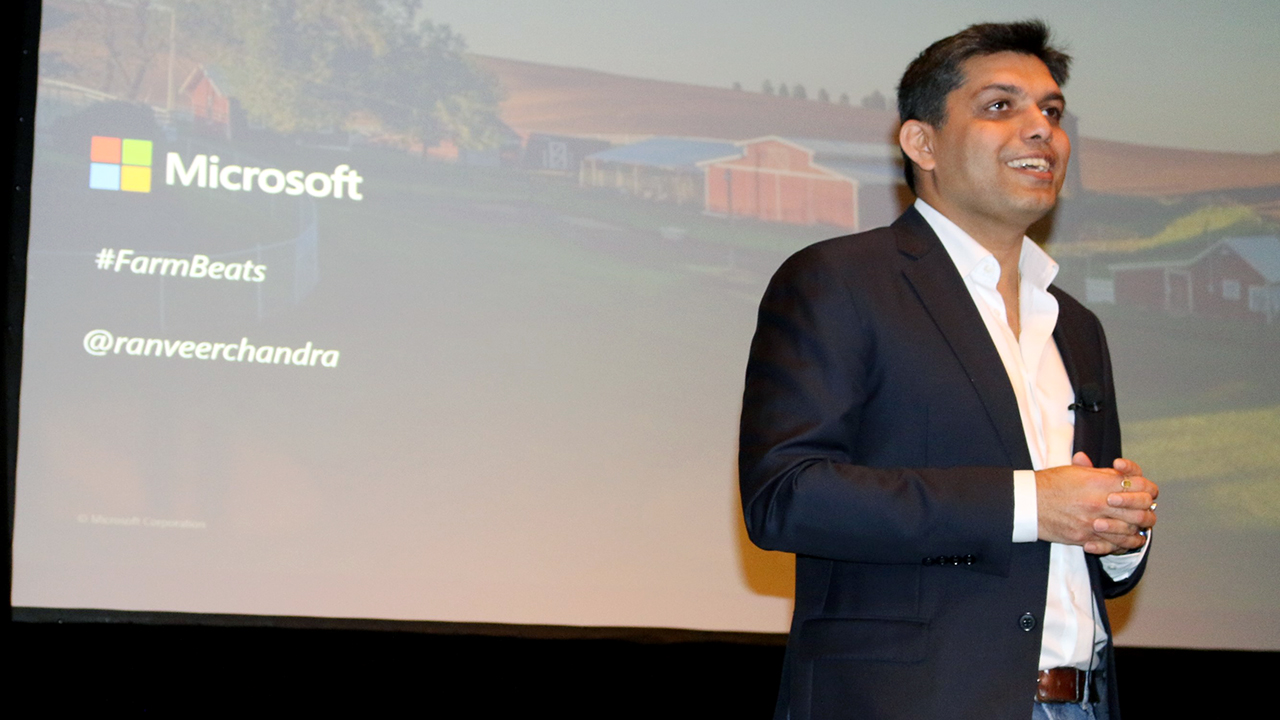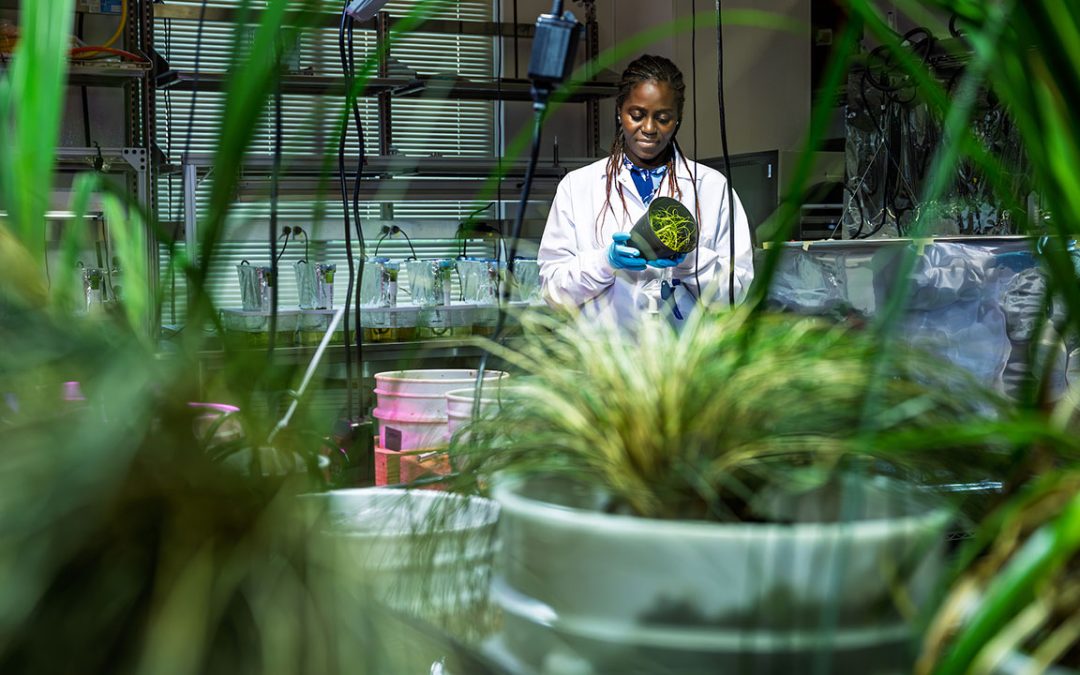Data-driven agriculture could help feed growing population
Land area is not increasing, soils are not getting any richer, and water levels are going down. So how do we reach the goal of increasing good food production to feed the planet?
One approach is through data-driven agriculture, says Ranveer Chandra, the Auburn University College of Agriculture’s E.T. York Distinguished Lecturer for Spring 2022. Chandra, who is CTO of Agri-Food at Microsoft where he leads research and innovation across different industry verticals including retail, FSI and energy, spoke on April 20, at the Auburn University Hotel and Conference Center.
Chandra started the FarmBeats project in 2015, which shipped as a Microsoft product in 2019. He has an undergraduate degree from the Indian Institute of Technology Kharagpur and a Ph.D. in computer science from Cornell University.
“My background is not in agriculture,” Chandra said. “I am a computer scientist by training, but I grew up in India, where I spent a lot of time going to my grandparents’ farm in one of the poorest states in India. At the time, I did not like anything having to do with agriculture or farming, but for the first 18 years of my life I spent a lot of time on these farms.
“Those times exposed me to a primitive form of agriculture, including hand seeding, and I’ve seen a lot of poverty as well. That drove me to start FarmBeats, a data-driven farming project designed to help increase farm productivity and reduce costs.”
The world needs more food, he said, but it’s not just about feeding the growing population.
“We need to give people good, nutritious food, and we need to grow this food without harming the planet in a sustainable way,” Chandra said. “There is a lot of innovative work going on at Auburn, and what we’re doing complements that. One of the approaches is data-driven agriculture.”
Data-driven agriculture would enable every farm in the world to use heatmaps to supply data about soil moisture levels, soil nutrient levels and other factors.
“Maps would enable technologies such as precision agriculture,” Chandra said. “Farmers could apply water where it is needed, pesticides where they are needed, and nutrients where they are needed. Precision agriculture can help farmers be more profitable, reduce costs, reduce the amount of chemicals they apply, save water, and help them grow more. And it’s also better for the planet.”
The entire food supply chain, from the input companies to the farmer, to the retailers and to the distributors, would benefit from data and data-driven insights, he said.
“In fact, if we could start sharing the data across the entire food supply chain, it could lead to even greater efficiencies and better business models,” Chandra said. “For example, some of these new business models include traceability, where you could track and trace and find out where food was grown in the supply chain.
“Farmers also could be paid for using good practices on the farm if they share data about what they are doing. These are all amazing opportunities from data-driven agriculture.”
Precision agriculture as a technology was proposed back in the 1980s, however, these technologies haven’t really taken off, Chandra said.
“The biggest reason they haven’t taken off is the cost of these digital agriculture solutions,” he said. “Five sensors for $8,000 is out of reach for most farmers. What’s the return on investment? The goal or the mission of the FarmBeats program is to significantly reduce the cost of these data-driven agricultural solutions”
The No. 1 reason existing technologies haven’t taken off on the farm is connectivity, Chandra said. Many farmers in the U.S. have connectivity to the Cloud, but the farm itself can be a few miles away, he added.
A recent USDA study showed that more than 70 percent of U.S. farmland doesn’t have satellite connectivity.
“One project we’re working on is called TV White Spaces,” Chandra said. “We took a WiFi signal and put it in empty TV channels. When you browse through channels on a TV, you see transmissions on some channels and white noise on others. We put a WiFi signal in the empty TV channels in a way that doesn’t interfere with regular reception.
“Farms are away from TV towers so there’s more white noise in rural areas giving the people who live there more capacity. This is a fundamental problem we have to work on if we want data-driven agriculture.”
Another FarmBeats projects is sparse sensor deployments.
“For an accurate map, a farmer needs lots of sensors because soil moisture can vary from row to row,” Chandra said. “And to build such an accurate map, you need a lot of sensors. But, they’re expensive to deploy and to manage.
“We reduced the number of sensors needed in a farm using multimodal artificial intelligence (AI). By combining aerial imagery and on-ground sensors, we need much fewer sensors to build heatmaps of farms. This allows us to use 10 times fewer sensors than what is otherwise needed to build accurate maps on the farm.”
The challenge with satellite imagery, Chandra said, is that over 70 percent of the earth is cloudy at any instance in time.
“If it’s cloudy, you really can’t see below the clouds,” he said. “We came up with another technology, SpaceEye, where we use AI to create much richer data sets so you can start building those maps. This allows for long-term imagery and research without interruption.”
Another challenge in agriculture, Chandra said, is connectivity from the farmer’s house to the Cloud. Many farmers pay for broadband, but all they get is 1 to 3 megabits of information.
“If you don’t have great connectivity to the Cloud, how can you bring the benefits of computer vision and artificial intelligence to growers?” he asked. “Many farmers have a PC they keep in their house or office. This PC, we call it an Edge device, can do a lot of computing as it sits in the farmer’s house or office.
“It would get data from the farm, perform a lot of computations, and then send the summaries of that to the Cloud. It would get data from drones and from sensors. The computer will be syncing with the Cloud. You know what’s going on, but you don’t rely completely on high-speed connectivity to provide these services.”
FarmBeats technologies have been deployed from ½-acre farms to 9,000 acres, Chandra said. On one farm in eastern Washington of more than 9,000 acres spread across 45 miles, sensors — using weather station data — predicted weather conditions for up to five days in advance, he said.
“It’s a product for other ag tech companies to build their solutions upon,” Chandra said. “Beyond this research and the products, we’re actually working with non-profits and academics to take the impacts of the work we’re doing to growers. We are using low-cost technologies to help democratize data-driven agriculture.”
The E.T. York Distinguished Lecturer Series was established in Auburn’s College of Agriculture in 1981 through a gift from the late E.T. York and wife Vam Cardwell York, both Auburn University alumni and native Alabamians. For more information, visit the website at www.agriculture.auburn.edu/yorklecture.





